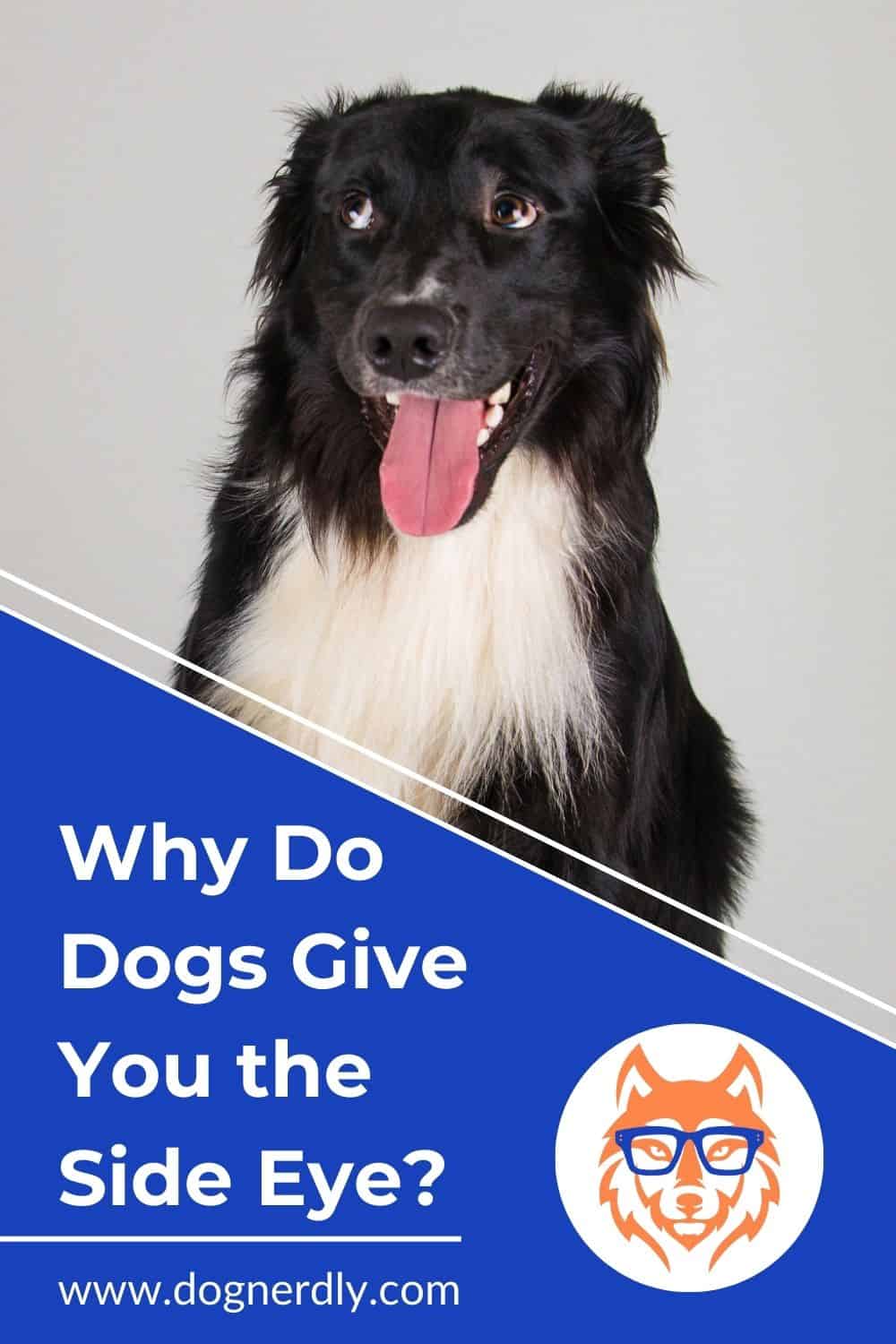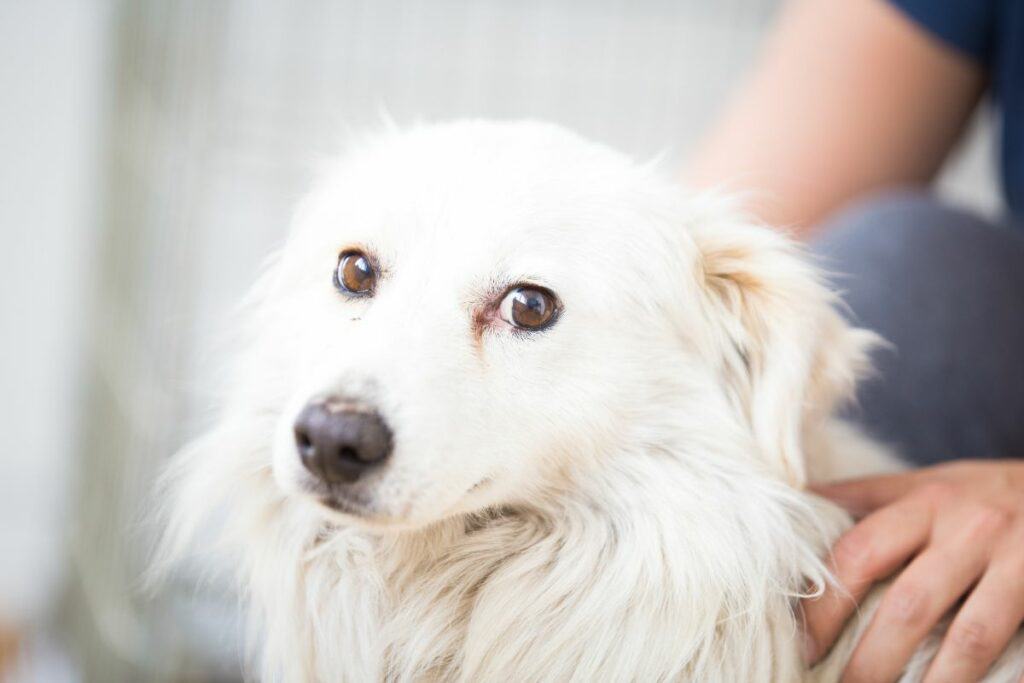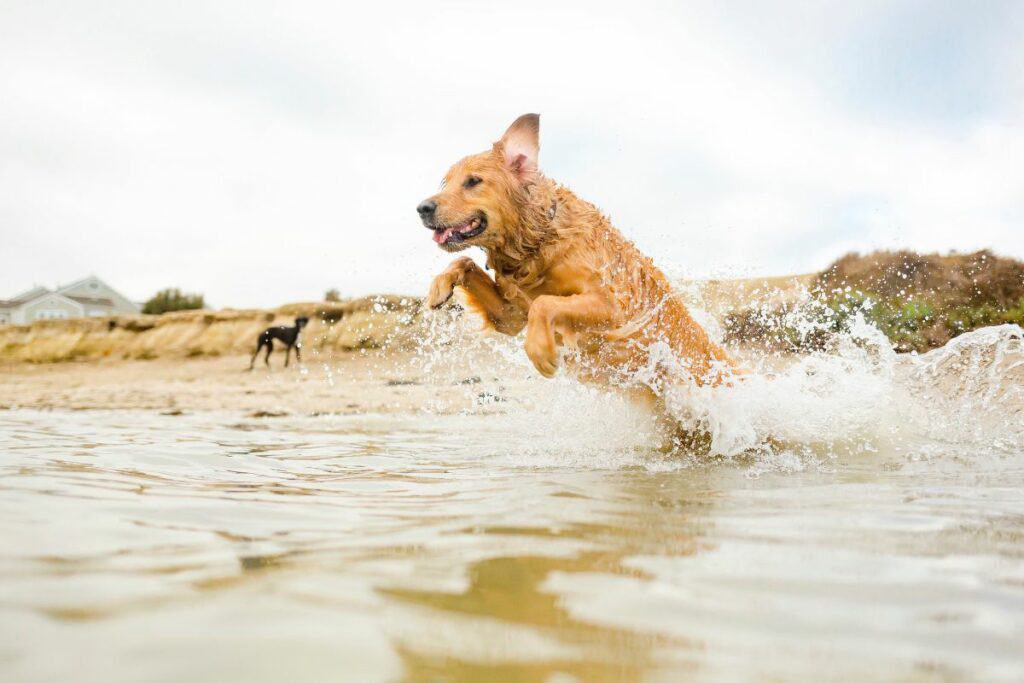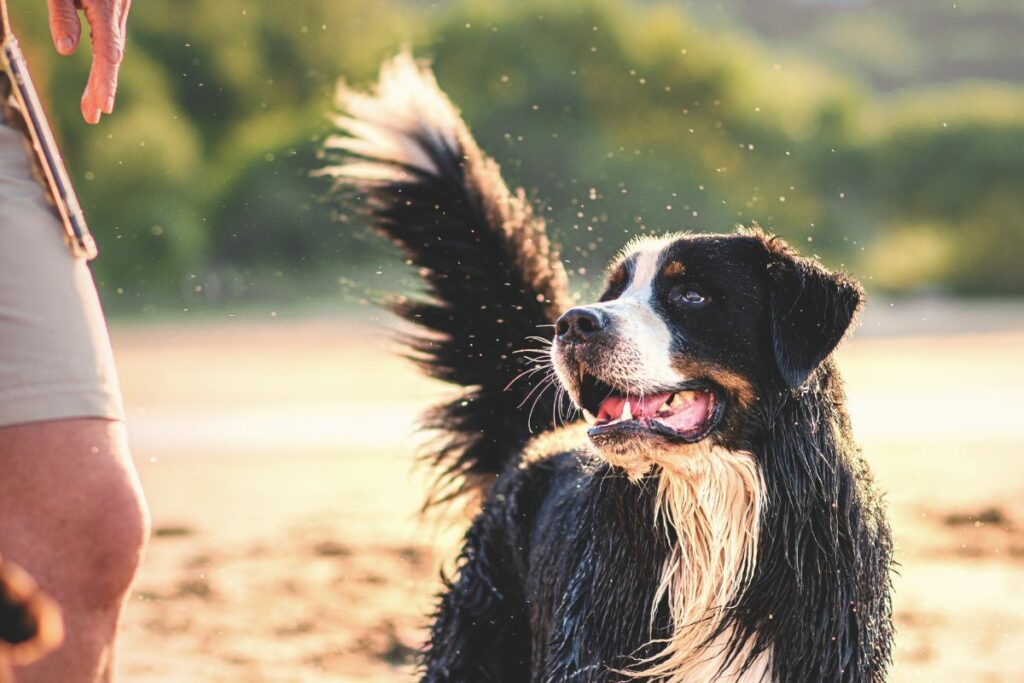Ever caught your canine companion throwing you a dog side eye and wondered what's going on in their mind? This subtle gesture is more than just a quirky look; it's a potential sign that your dog is stressed or fearful. Let’s dive into what a side-eye means and how to manage a potentially unsafe situation.
What Does a Dog Side Eye Mean?
In the intricate language of canine communication, what many refer to colloquially as the "dog side eye" is more accurately known in the dog world as the "whale eye." Unlike the playful or mildly inquisitive side glances dogs sometimes give, the whale eye is a specific, critical signal that should prompt immediate attention and caution from dog owners. It can be recognized by a half moon shape made by the whites of a dog’s eye. This only happens when dogs exaggerate the size of their eyes when staring with intensity.
A whale eye occurs when a dog shows the whites of its eyes significantly, usually by turning its head away but keeping its gaze fixed on something or someone. This behavior is not merely an everyday look or a casual glance; it is a clear expression of discomfort, severe stress, or fear. The visibility of the whites of a dog's eyes—reminiscent of a whale's eye, hence the name—is a distress signal indicating that the dog is in a state of heightened anxiety and could react unpredictably if the stressor persists or approaches.
Understanding that the whale eye is a manifestation of severe emotional distress is crucial. This recognition necessitates a careful, compassionate response. When a dog displays this behavior, it is critical for the safety and well-being of both the dog and its human companions to approach the situation with sensitivity. Recognizing this signal as a plea for space and comfort allows owners and others to de-escalate potentially threatening scenarios by removing the stressor or giving the dog the distance it needs to feel secure.
Differentiating a Dog Side Eye from Other Looks
Understanding the nuances between a whale eye, a look away, and an averted gaze is key to deciphering your dog's communications. A look away or an averted gaze generally means your dog is disengaging from the situation, signaling a desire to avoid confrontation or indicate they are not a threat. A look away usually involves the head turning in the direction of the eyes so there is little to no white showing. An averted gaze happens when you make eye contact with a dog, and they avert their eyes suddenly. In dog body language, this is what we call an appeasement behavior. The dog is simply trying to communicate that it is not a threat and does not wish to engage.
Whale eyes are very different and can be easy to recognize if you know what to look for. They are usually accompanied by stiff body posture. It is an indicator of intense emotion, usually fear, and the dog will usually hold their position until the cause of that fear is removed. Generally, the more white of their eye you can see, the more intense the emotion.
It can take more than a few pictures to fully recognize a whale eye, but below are some examples. In my personal experience, when teaching students at The Academy of Pet Careers about canine body language, it is best to look at the whole body. Is the dog stiff or loose? Are they leaning in or away from you? Are their ears pinned back or loose? With these clues, you can better recognize a stressed dog.



Common Scenarios for a Whale Eye
Understanding when and why a dog displays this can significantly improve human-canine interactions. Here are three common scenarios where you might observe a whale eye:
- Feeling Cornered or Threatened: Dogs, much like humans, have a strong sense of personal space and can feel trapped or cornered even in familiar environments. This feeling of entrapment doesn't necessarily come from physical barriers; it can also arise in social situations where the dog feels overwhelmed by attention or interaction. In these moments, the whale eye can be a clear signal of discomfort. It's as if the dog is saying, "I need some space." The whites of their eyes become visible as they try to keep an eye on the perceived threat while avoiding direct confrontation.
- Resource Guarding: A classic scenario for the whale eye is resource guarding. Dogs may guard food, toys, favorite spots, or even people, perceiving others as potential threats to their valued resources. The behavior here serves as a warning—a sign that the dog is prepared to protect what they value if pushed. It's an indication of the dog's anxiety about the possibility of losing the resource and a preemptive measure against perceived threats.
- Discomfort During Handling: Not all dogs enjoy being handled, whether it's for grooming, vet visits, or even cuddling. When a dog feels uncomfortable or restrained, they might show the whale eye as an expression of their unease. This scenario is particularly common in situations where the dog cannot escape the handling, such as during nail trimming or when being hugged. The whale eye reflects the dog's conflict between enduring the discomfort and the desire to express a defensive response.
In each of these scenarios, the dog is highly fearful and may result in aggression if the situation does not improve. Recognizing a whale eye in these scenarios is vital for dog owners and handlers, allowing them to respond appropriately to the dog's emotional state. By acknowledging and respecting these signals, we can take steps to alleviate the dog's stress, such as giving them space, stopping the uncomfortable interaction, or slowly desensitizing them to the stressor under guidance from a professional.
What to Do When Your Dog Shows You a Side Eye
When you notice your dog showing a whale eye, the first step is to assess the situation calmly. Give them space, avoid direct eye contact, and refrain from approaching or touching them if they seem stressed. We've come up with the following steps to assess the stress level of your dog and overcome a fearful situation:
- Remove yourself from the space: Since a whale eye is usually triggered by a person or the protection of an object, by removing yourself, the dog should calm down. Start with a few steps and see if their body loosens up. If not, take a few more steps until your dog calms down.
- Change the environment: In many cases, a change in environment can help reset the dog. Ask them to go outside or move to another room where there are no resources to guard. Once the dog is removed from the space, you can then retrieve the item being guarded and make it disappear.
- Re-engage the dog/space: Once the dog is in a healthy mindset and has calmed down, you can return them to the space and/or give them back their object. If the dog doesn’t show signs of a whale eye, then it was most likely a misunderstanding of the situation. If they return to their state of fear and show stiff body language, there is an underlying issue that may require the help of a professional.
Whale eye expressions are frequently accompanied by aggressive behavior and can be hard to overcome. It may require the help of a professional animal behaviorist to address underlying issues. If you choose to seek out an expert, make sure they are proficient with the use of positive reinforcement and avoid the use of punishment. Punishment will only increase arousal and strengthen the underlying emotion driving the behavior. It will most likely make it worse.
Dog Breeds and Their Propensity to Show Whale Eye
When it comes to canine communication, not all dog breeds express themselves in the same way. Some breeds are more expressive with their eyes, including the display of a whale eye, due to physical characteristics, breed-specific behaviors, or both. Understanding the tendencies of different breeds can help owners better interpret their pets' body language and respond to their needs effectively.
Breeds with Physical Predispositions
Certain breeds have physical features that make the whale eye more pronounced or more frequently visible. Breeds with larger eyes and those with a naturally wide eye shape, such as the Boston Terrier, Pug, or French Bulldog, may display what looks like a whale eye during normal, non-stressful situations simply due to their facial structure. However, it's crucial to distinguish these physical traits from a genuine whale eye expression, which is a behavioral signal rather than a breed-specific feature.
Breeds with Behavioral Tendencies
Breeds known for their strong guarding instincts or high sensitivity to their environment, such as German Shepherds, Doberman Pinschers, and Australian Shepherds, may be more prone to showing a whale eye in situations where they feel threatened, protective, or unsure. These dogs are highly attuned to their surroundings and may use a whale eye to signal discomfort or alertness before escalating to more overt signs of distress or aggression.
Recognizing that certain dog breeds may be more prone to showing a whale eye, whether due to physical characteristics or behavioral traits, highlights the importance of breed-specific knowledge in understanding canine body language. Owners should approach each dog as an individual, considering both their breed tendencies and personal history when interpreting signals like the whale eye. This nuanced understanding fosters a deeper, more empathetic relationship between dogs and their owners, ensuring that the needs and feelings of our canine companions are respected and met with kindness.
The Significance of Body Language in Dogs
A comprehensive understanding of canine body language, including nuances like the side eye and whale eye, empowers owners to foster a deeper connection with their canine companions. Recognizing these signals enables owners to respond more effectively to their dogs' needs, improving their mutual relationship and preventing potential misunderstandings that could lead to fear or aggression.
When speaking with pet owners or professionals, this is always the first thing I recommend learning. Without a foundation of good communication, it is nearly impossible to understand your dog's needs. Check out some of our other articles on canine body language and start learning how to better communicate with your pet.
Frequently Asked Questions
A relaxed side eye is usually not a whale eye, but an averted gaze. Especially in a calm environment, it can be a sign of your dog's playful mood or a mild curiosity about your actions without the desire to engage fully.
Context and body language are key. A playful side eye is usually accompanied by a relaxed body posture, wagging tail, and an overall playful demeanor. In contrast, a warning side eye may come with stiffening of the body, growling, or bared teeth.
While often associated with stress or discomfort, the whale eye can sometimes be misinterpreted. Always consider the full context, including the environment and other body language cues, before jumping to conclusions.
Excessive side eye behavior, especially if sudden or accompanied by other signs of discomfort, could indicate pain or health issues. It's best to consult a veterinarian to rule out any medical concerns.
Children should be taught to recognize and respect a dog's space when they notice a side eye, as it can be a sign that the dog is uncomfortable or needs time alone. Educating children on the importance of not approaching, touching, or staring at a dog displaying this body language is vital for both the child's and the dog's safety. Instead, they should be encouraged to calmly move away and inform an adult about the dog's behavior. Creating a safe environment involves teaching both dogs and children how to interact respectfully and understanding each other's communication signals.

Joseph Schifano is the President of The Academy of Pet Careers and Founder of DogNerdly.
With over 20 years of professional pet experience, Joseph got his start as an owner/operator of a 7-figure, all-inclusive pet care business. From there, he purchased The Academy of Pet Careers with a hopes of improving the quality of care provided by industry professionals. This role allowed Joseph to rub shoulders with some of the biggest names in the industry, and gain knowledge in every aspect of pet care.
After witnessing the popularity of social media influencers and the amount of misinformation being taught to pet parents, Joseph decided to create DogNerdly. The goal was to provide science-backed education for the average dog nerd in order to create a world where dogs and humans can live a more harmonious and empowered lifestyle.




